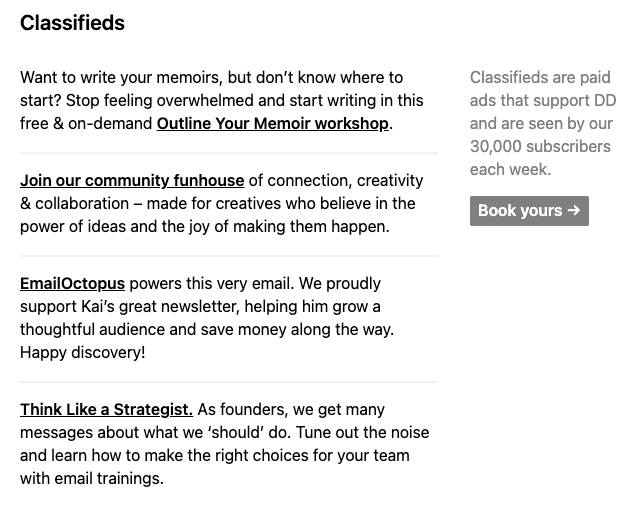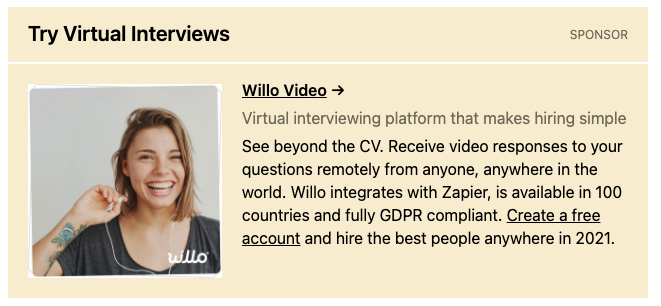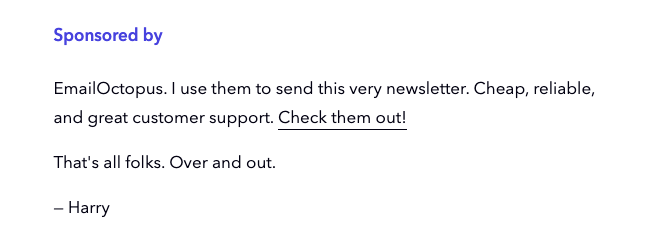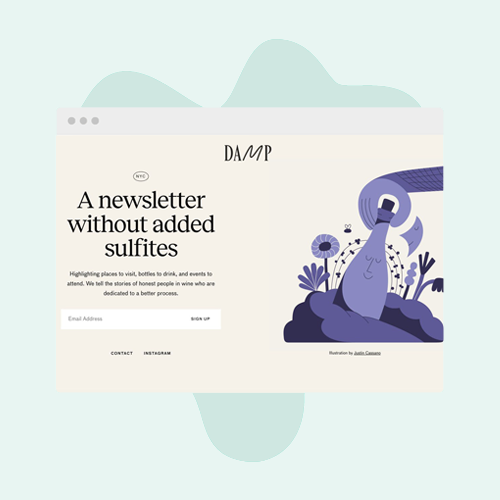You’ve started your first newsletter and got a few thousand subscribers on your list. Now it’s time to make some money and get your newsletter generating revenue.
But how do you do that?
Well, there are two ways you can monetise your newsletter:
- Selling to brands – sponsorships, display banners and classified ads
- Selling to consumers – subscriptions, memberships and donations
And in this article, we’re going to guide you through the first option – how to sell to brands. By the end, you’ll know how to find sponsors, how to pitch your newsletter and how to decide on what prices to charge.
But first, let’s start with a little prep work.
Page Contents
Three-step guide for preparing your newsletter for sponsorship
Before rushing out to find sponsors for your newsletter, it’s a good idea to take the time to figure out exactly what it is you’re offering.
Step 1: Decide on the type of sponsorship you want to offer advertisers
There are a few different ad formats you can sell to advertisers. Here are three of the most popular.
Classified ads
Traditionally, classified ads were small messages displayed in newspapers under certain classifications. For example, real estate, travel, automotive.
Digital newsletter creators have adopted this print tradition by including a section of their newsletter dedicated to a collection of small ads.
Here’s an example from EmailOctopus customer Dense Discovery:

Classified ads are normally text-only and range between 20-50 words with a single trackable link.
What’s great about classified ads is that you can sell multiple ad spaces in one edition of your newsletter. And you’re able to present the classifieds in a way that doesn’t interfere with the rest of your newsletter content.
As classified ads tend to be on the lower end of the price range, advertisers are more likely to book a bundle of slots, rather than a one-off ad. This helps you secure revenue further in advance.
Sponsored email
A sponsored email tends to include a larger ad placed towards the top of a newsletter. Which makes it more prominent. And means you can charge a lot more than classified ads.
You could either offer exclusive sponsorships, where the advertiser is the only brand mentioned in the newsletter. Or if not exclusive, then you could provide sponsors with more valuable ad space, give them more text to play with, and include an image.
Returning to our friend at Dense Discovery, here’s what a sponsored ad might look like:

Sponsored emails are attractive to advertisers, especially if it’s an exclusive deal. The phrase “this newsletter is sponsored by <brand name>” sounds less salesy than “classified ads”. And having an ad at the very top of a newsletter is likely to drive more clicks. So better performance for the advertiser.
You could also offer a sponsorship package to provide advertisers with more reach. Depending on your set up, you might also want to throw in display ads on your website, sponsored content such as a blog article, or shout outs on your social media channels.
Dedicated email
A dedicated email is essentially a promo email that you send to your audience. You essentially “rent out” your audience to brands and they pay to deliver their message. Dedicated emails can demand much higher prices and make you more money. But they should be approached with caution.
Your audience didn’t sign up to your newsletter to receive promo messages. And you run the risk of losing subscribers, especially if the message doesn’t provide your audience with any real value. That’s why it’s best avoided, unless you’re confident you can get it right.
If there’s a brand out there that you know your audience would love, and they can align their message with your newsletter’s purpose and voice, then it could pay off. Especially if the message is packed with valuable content that helps your audience solve a problem.
But otherwise, steer clear. Stick to sponsored emails instead.
Whichever option you decide on, think about how each ad type will look in your newsletter. And mock up a few designs to help you decide on the final format. This also gives you examples to provide advertisers with when you start pitching.

Step 2: Calculate your prices
Next, you’ll need to set your prices. The cost of newsletter ads varies considerably. And it’s largely dependent on subscriber count and open rate. Though if you’re prepared to add more than just newsletter ad space, these won’t be the only measures.
For example, if you’re offering an exclusive sponsorship, you could also offer advertisers a display banner on your website. Or shoutouts on your social media channels. This gives you the opportunity to charge more, as you’re providing advertisers with the chance to reach more of your audience.
Advertisers will benefit more from an ongoing sponsorship over a number of newsletter editions, as a one-off ad might not make a big enough impact in building brand awareness. So when pricing sponsored emails, offer more attractive pricing for longer-term partnerships.
How to set your newsletter sponsorship rates
There are two ways to calculate your ad prices:
- Flat fee
- CPM
Flat fee
Negotiating and selling ads for a flat fee works well for newsletters with a smaller audience. And if you plan to offer sponsorship packages that include, for example, additional sponsored content promoted across other channels you own.
When pricing a sponsorship package, many factors will be at play, such as number of website visitors, podcast downloads and social media followers. Depending on those numbers and how well your audience fits the advertiser’s target market, you could command anywhere between $2,500 to $5,000 for a three-month sponsorship package.
Even if you decide to charge a flat fee, it pays to calculate what that might equate to in terms of CPM. Because this is what advertisers will be using to compare their options. And it gives you a good baseline to work from.
CPM
CPM stands for “cost per mille” and denotes the price of 1,000 impressions. For a newsletter, the CPM is how much it costs to reach 1,000 subscribers, and it’s calculated as:
CPM = (Cost of ad in email send / No. of email subscribers) x 1,000
If you’re planning on charging by CPM, it’s a good idea to check out what other newsletters in your niche are offering. The goal is to be within the range of what advertisers might find elsewhere.
Keep in mind that advertisers will be benchmarking their ad spend against this common metric to understand what provides them with the best value and ROI.
So do a little research and make sure your pricing is competitive. If a similar newsletter to yours is charging a CPM of $50, you’ll lose advertisers if you charge $150. Unless you have much higher engagement rates or can demonstrate that your audience is more likely to take action after seeing the ad.
The CPM you charge will also depend on how many other ads are in the newsletter. And whether an advertiser is competing for attention. The more exclusive the ad, the more you can charge.
If you’re just starting out with newsletter ads, charging a CPM between $15 to $30 is a good range to aim for. Classified ad space alongside a number of other brands might mean you have to offer a lower CPM between $5 and $15.
However, if your newsletter is more established with a highly targeted and engaged audience, you can confidently charge a CPM between $30 to $50. Premium newsletters might even get away with a CPM of $50+.
Whatever pricing structure you decide on, be open to negotiations when you start dealing with sponsors. If you can be flexible, you increase your chances of building a longer, more profitable relationship.
A word on vCPM
The ‘v’ in vCPM stands for “viewable”, and it refers to the number of subscribers that actually open the email.
It’s a metric more commonly used by advertisers to determine the performance of campaigns, but it can be a useful calculation for newsletter publishers selling ad space too.
Because if you can offer a better value vCPM, you can get away with charging a higher CPM.
For example, you have a list of 2,000 subscribers. A newsletter in your same niche, with the same size audience, is charging $30 per ad. So you’re thinking of charging the same, which is a CPM of $15:
- ( $30 / 2,000 subscribers ) x 1,000 = $15 CPM
However, your newsletter has an open rate of 45%. While your competitor has an open rate of just 25%. This means you can provide advertisers with a vCPM of $33.33 while your competitor is higher at $60 vCPM:
- You: ($30 / ( 2,000 x 45%)) x 1,000 = $33.33 vCPM
- Competitor: ($30 / ( 2,000 x 25%)) x 1,000 = $60 vCPM
Essentially, it’s cheaper for advertisers to get their ad in front of people with you than your competitor. And in this scenario, you could charge as much as $50 for an ad and still offer a more competitive vCPM than the other newsletter.
Again, this requires some research on your part to see what you’re up against. Having an idea of what others are charging helps you remain competitive in your pricing.
Step 3: Create a sponsor page on your website
Now that you’ve got your ad formats and prices settled, it’s time to put it altogether on a web page that you can share with advertisers. This page will often either be called a ‘sponsor’ page or an ‘advertise with us’ page.
And on your sponsor page, you should include this key information:
- Total number of subscribers
- Engagement metrics, including open and click rates
- Demographic of subscribers – location, age, profession and whatever additional, relevant information you have about your audience
- Examples of past advertisers
- Types of advertisements available, their format and price
Here’s an example from EmailOctopus customer TLDR:

You could also include a link to an ad booking system, if you have one. That way, advertisers can see availability and book ad slots quickly and easily.
If you don’t have an ad booking system, ask advertisers to contact you. Or link to a simple customised Google Form asking for information so that you can get back to them with options. You can use the EmailOctopus landing page builder for this, or work with one of many other landing page builders out there, many of them free, both options allow you to create a page within 20 minutes.
And don’t forget to update this page regularly as your subscriber count grows and engagement metrics change.
How to sell advertising space in your newsletter
Now that you’ve got everything prepped and ready to go, it’s time to find some sponsors.
In an ideal world, advertisers would come to you. They’d find your sponsor page, get in touch and start throwing money at you for ad space in your newsletter.
This might happen occasionally. But you certainly can’t rely on it happening. Instead, you need to get your newsletter out there in front of the eyes of potential sponsors.
And there are two main ways to do this – outreach or marketplace platforms.
Outreach
With outreach, the onus is on you to contact businesses with a target audience that aligns with yours. You’ll need to persuade businesses why advertising in your newsletter will benefit them.
Cold outreach is daunting for many publishers. But it’s a good way to start developing relationships with potential advertisers. And even if they don’t say yes straight away, they might one day come back to you. Or recommend you to another business in the industry.
Here’s a few tips to help make your outreach campaign less scary and more successful.
Shortlist suitable advertisers
Start with products or services that you use and would confidently recommend to your audience, even if money wasn’t involved. The products and services should really be relevant to the theme and topics of your newsletter so that the ads don’t seem out of place.
You could also research newsletters in your niche to see which brands sponsor them. There’s a good chance that if a brand is targeting a similar audience to yours in another newsletter, they’d want to try advertising in your newsletter too. There’s a choice of tools available to help with this task, including:
But just remember, when making your shortlist, choose brands that align with your values, and the values of your audience. Promoting products or services that are at odds with your values will alienate your subscribers, which is the last thing you want to do after all that hard work of building your audience in the first place.
Pitch your newsletter to advertisers
When it comes to pitching your newsletter to advertisers, you need to persuade potential sponsors that your audience is a perfect fit with their target audience. You also need to demonstrate that your audience is engaged.
Subscriber demographics and metrics like open and click rates are essential. But if you can provide more info about what interests and motivates your audience, you can help advertisers craft a more compelling message. Which they’ll appreciate.
The more successful you can make an advertiser, the more likely they will be to sponsor your newsletter. And continue doing so in the future.
If you’re approaching businesses whose products or services you personally use, suggest adding a little social proof alongside the ad in your newsletter. This popular marketing psychology hack will help the ads perform better. Which increases your chances of getting that sponsorship.
Here’s an example from our customer Harry Dry and his Marketing Examples newsletter:

As you run more and more sponsored newsletters, ask advertisers for campaign performance stats. Your pitch will be even more persuasive if you can demonstrate how advertising in your newsletter has delivered a ROI to other advertisers.
For more tips on composing outreach emails, read this step-by-step guide to approaching sponsors by TLDR newsletter creator Dan Li. He’s grown his newsletter to over 150,000+ subscribers so knows a thing or two!
Marketplaces
If you prefer to sit back and wait for advertisers to come to you, then list your newsletter on sponsorship marketplaces.
Hecto, Paved and Letterwell are great places to start.
These online platforms connect newsletter publishers with advertisers. Normally all you need to do is submit details of your newsletter and the ad space you’re selling.
Advertisers browse these marketplaces looking for newsletters with the right audience. Once found, the advertiser can either book ad space directly in the platform or get in touch to discuss more details.
Hopefully from there, you secure a sponsor and develop a relationship that will continue to pay off in the future.
Wrapping up
And there you have it – a complete guide on how to get sponsors for your newsletter.
We’ve taken you from the early prep work required to get your newsletter ready for sponsorship. All the way through to outreach and listing your newsletter on sites that will do the hard graft for you.
Now it’s over to you – go make some money!



No Comments
Leave a comment Cancel